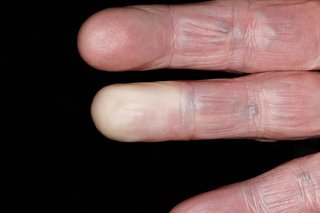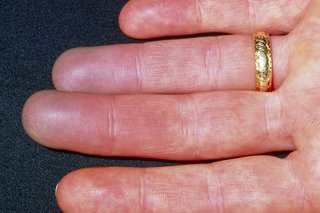Raynaud's phenomenon is where your blood stops flowing properly to your fingers and toes. It's common and does not usually cause severe problems. You can often treat the symptoms yourself by keeping warm. Sometimes it can be a sign of a more serious condition.
Symptoms of Raynaud's
Raynaud's affects your blood circulation. When you're cold, anxious or stressed, your fingers and toes may change colour.
Other symptoms can include:
- pain
- numbness
- pins and needles




Some people also find that their ears, nose, lips or nipples are affected.
The symptoms of Raynaud's may last from a few minutes to a few hours.
Raynaud's is sometimes caused by another health condition, taking certain medicines, or working with vibrating tools for a long time.
If you're not sure it's Raynaud's
| Symptoms | Possible causes |
|---|---|
|
Pins and needles that lasts for a few minutes |
Resting or sleeping on part of the body |
|
Breathing too quickly, trembling hands, pins and needles, but fingers do not change colour |
Hyperventilation |
|
Burning or itchy swelling on fingers and toes, happens after being very cold, gets worse as you warm up |
Things you can do to help with Raynaud's
If you have Raynaud's:
Do
-
keep your home warm
-
wear warm clothes during cold weather, especially on your hands and feet
-
try to avoid sudden changes in temperature
-
exercise regularly – this helps improve circulation
-
try breathing exercises or yoga to help you relax
-
eat a healthy, balanced diet
Don’t
-
do not smoke – improve your circulation by quitting smoking
-
do not have too much caffeine (found in tea, coffee, cola and chocolate) – it may trigger the symptoms of Raynaud's
Non-urgent advice: See a GP if:
- you have symptoms of Raynaud's that are very bad or getting worse
- Raynaud's is affecting your daily life
- your symptoms are only on 1 side of your body
- you also have joint pain, skin rashes or muscle weakness
- you're over 30 years old and get symptoms of Raynaud's for the first time
- your child is under 12 years old and has symptoms of Raynaud's
Treatment for Raynaud's from a GP
If you have Raynaud's and your symptoms are very bad or getting worse, a GP may prescribe a medicine to help improve your circulation. For example, you may be offered nifedipine, which is used to treat high blood pressure.
Some people need to take this medicine every day. Others only use it to prevent Raynaud's, for example, during cold weather.
A GP may arrange tests if they think Raynaud's could be a sign of a more serious condition, such as rheumatoid arthritis or lupus.
Support from Scleroderma and Raynaud's UK (SRUK)
SRUK is a charity for people with scleroderma or Raynaud's.
Page last reviewed: 20 July 2023
Next review due: 20 July 2026